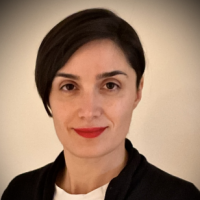SystemX Affiliates: login to view related content.

*To receive email announcements and live stream information for upcoming seminars, please subscribe to the SystemX Seminar/EE310 Mailing list here.
Tunable integrated photonic devices working at the visible and near infrared (NIR) regions are needed in a variety of applications ranging from consumer market to DoD sector and space. From a large selection of materials which can provide tunability to optical components, phase change materials stand out due to their reliable phase transitions and relatively large change in their optical and electrical properties as they go through crystallographic phase transition. Specifically, Germanium Telluride-based compounds, such as Germanium Telluride (GeTe), exhibit very different optical and electrical properties when they undergo phase transitions. Compared to the more commercialized GST material, GeTe has a much simpler fabrication process, more reliable phase transitions and lower loss at the visible wavelength. Two stable phases of GeTe exist at room temperature: amorphous (a-GeTe) and crystalline (c-GeTe), which have drastically different optical and electrical properties at NIR and noticeable differences in the visible range. These unique properties of GeTe is used in our work to implement components with application in novel displays, reconfigurable metamaterials-based devices, and acousto-optic diffraction grating. This talk goes over some of the fundamental design principles used to overcome the challenges posed by limitations of the material in the NIR regime and shows some of the first-of a kind electro-optical devices implemented for space and DoD applications using GeTe.
Mina Rais-Zadeh (S’03-M’08-SM‘12) received the B.S. degree in electrical engineering from Sharif University of Technology and M.S. and Ph.D. degrees both in Electrical and Computer Engineering from Georgia Institute of Technology in 2005 and 2008, respectively. From 2008 to 2009, she was a Postdoctoral Research Fellow at Georgia Institute of Technology. In 2009, she joined the University of Michigan, Ann Arbor, as an Assistant Professor of Electrical Engineering and Computer Science (EECS). From 2014-2018 she had been a tenured Associate Professor in EECS with courtesy appointment in the Department of Mechanical Engineering. She is currently leading the MEMS and micro-instrument development activity at JPL as a group supervisor for the Advanced Optical and Electromechanical Microsystems Group. Mina is the recipient of the NSF CAREER Award (2011), IEEE Electron Device Society Early Career Award (2011), NASA Early Career Faculty Award (2012), the Crosby Research Award from the University of Michigan (2013), National Academy of Engineering Frontiers of Engineering (2013), ONR Young Investigator Award (2014), IEEE Sensors Council Early Career Technical Achievement Award (2015), and University of Michigan EECS Outstanding Achievement Award (2016). Together with her students, she received the best poster award at the Transducers conference (2013), the best paper award at the IEEE SiRF conference (2014, 2016), honorable mention at the IEEE IMS (2014), and was the finalist in student paper competitions at the SiRF (2007) and IMS (2011) conferences. Her research interests include electron devices for wireless communication and sensing applications and the related device physics, resonant micromechanical devices, RF MEMS, gallium nitride MEMS, and micro/nano fabrication process development.


